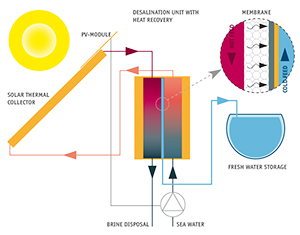Technology description
Membrane Distillation (MD) is a thermal process in which pure water vapor, driven by a difference in temperature, passes through a hydrophobic membrane and condenses on the opposite side
Contrary to membranes for reverse osmosis (RO), which have a pore diameter in the range of 0.1 to 3.5 nm, membranes for membrane distillation generally have a pore diameter of 0.1- 0.4 microns. The separation effect of these polymer membranes is based on their hydrophobic nature. This means that up to a certain limiting pressure, the surface tension retains liquid water from entering the pores, but molecular water in the phase of vapour can pass through the membrane. The figure below illustrates the operating principle of membrane distillation. On the one side of the membrane there is salt water, for example at a temperature of 80░C (hot feed). When there is a lower temperature on the other side of the membrane e.g. by cooling the condenser foil to 75░C a vapour pressure difference for water vapour across the membrane esists. This is the driving force that makes the vapour pass through. The water vapour condenses on the low-temperature side and distillate is formed.
The MD-modules can be directly connected to a corrosion free solar thermal collector without heat storage. MD offers important advantages for the construction of solar-driven or waste-heat driven, stand-alone desalination systems. The most important advantages of MD desalination technology are:
À The operating temperature of the MD process is in the range of 60 - 85 ░C. This is a temperature level where solar thermal collectors perform well.
À Costly chemical pre-treatment of the water supply is in most cases not necessary.
À Operation of the MD- module with intermittent energy supply is possible even without heat storage.
À Robust and easy to use technology
